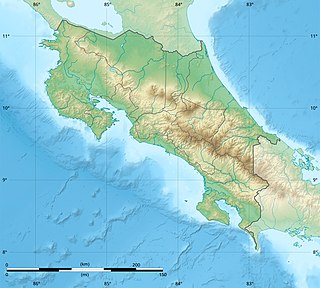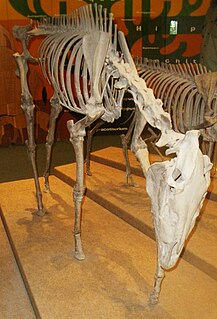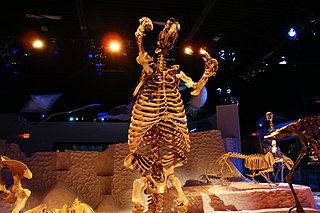 W
WAelurodon is an extinct canine genus of the subfamily Borophaginae which lived from the Barstovian land mammal age of the middle Miocene to the late Miocene epoch. Aelurodon existed for approximately 10.7 million years .
 W
WThe Alachua Formation is a Miocene geologic formation in Florida. The claystones, sandstones and phosphorites of the formation preserve many fossils of mammals, birds, reptiles and fish, among others megalodon.
 W
WThe Alajuela Formation, originally Alhajuela Formation (Tau), is a Late Miocene geologic formation in the Panama Canal Zone of central Panama.
 W
WBorophagus hilli is an extinct species of the genus Borophagus of the subfamily Borophaginae, a group of canids endemic to North America from the Late Miocene until the Pliocene.
 W
WThe Chagres Formation (Tc) is a geologic formation in the Colón Province of central Panama. The sandstones and siltstones were deposited in a shallow marine environment and preserve fossils dating back to the Middle to Late Miocene period.
 W
WThe Citronelle Formation is a Hemphillian geologic formation in Georgia, Alabama, Florida, Mississippi and Louisiana.
 W
WCormohipparion is an extinct genus of horse belonging to the tribe Hipparionini that lived in North America during the late Miocene to Pliocene.
 W
WCranioceras is an extinct genus of artiodactyl from the Miocene to the Pliocene in the United States.
 W
WThe Curré Formation is a geologic formation of the Taraba Basin Group in Costa Rica. The deltaic conglomerates preserve fossils dating back to the Late Miocene to Early Pliocene period (Hemphillian).
 W
WDinohippus is an extinct equid which was endemic to North America from the late Hemphillian stage of the Miocene through the Zanclean stage of the Pliocene and in existence for approximately 6.7 million years . Fossils are widespread throughout North America, being found at more than 30 sites from Florida to Alberta and Panama.
 W
WThe Gatún Formation (Tg) is a geologic formation in the Colón and Panamá Provinces of central Panama. The formation crops out in and around the Panama Canal Zone. The coastal to marginally marine sandstone, siltstone, claystone, tuff and conglomerate formation dates to the latest Serravallian to Tortonian, from 12 to 8.5 Ma. It preserves many fossils, among others, megalodon teeth have been found in the formation.
 W
WThe Goliad Formation (Tg) is a geologic formation in Texas. It preserves fossils dating back to the Serravallian to earliest Pliocene stages of the Neogene period, including the gomphothere Blancotherium among many other fossil mammals, reptiles, birds and fish.
 W
WHorned gophers are extinct rodents from the genus Ceratogaulus, a member of the extinct fossorial rodent family Mylagaulidae. Ceratogaulus is the only known rodent genus with horns, and is the smallest known horned mammal. Ceratogaulus lived from the late Miocene to the early Pliocene epochs.
 W
WMegalonyx is an extinct genus of ground sloths of the family Megalonychidae, native to North America during Pleistocene epoch. It became extinct during the Quaternary extinction event at the end of the Rancholabrean of the Pleistocene, living from ~2.4 Mya—11,000 years ago. The type species, M. jeffersonii, measured about 3 meters (9.8 ft) and weighed up to 1,000 kilograms (2,200 lb). Megalonyx is descended from Pliometanastes, a genus of ground sloth that had arrived in North America during the Late Miocene, prior to the Great American Biotic Interchange. Megalonyx had the widest distribution of any North American ground sloth, having a range encompassing most of the contiguous United States, extending as far North as Alaska during warm periods.
 W
WMegatylopus is an extinct genus of large camel, endemic to North America from the Late Miocene to the Pliocene, existing for approximately 7.4 million years . Fossil distribution ranged from North Carolina to California. It stood about 4.2 metres (14 ft) tall.
 W
WNeohipparion is an extinct genus of equid, from the Neogene of North America and Central America.
 W
WPlatygonus is an extinct genus of herbivorous peccaries of the family Tayassuidae, endemic to North and South America from the Miocene through Pleistocene epochs, existing for about 10.289 million years .
 W
WPliohippus is an extinct genus of Equidae, the "horse family". Pliohippus arose in the middle Miocene, around 15 million years ago. The long and slim limbs of Pliohippus reveal a quick-footed steppe animal. While some specimens have one toe per leg, others have three.
 W
WProcamelus is an extinct genus of camel endemic to North America. It lived from the Middle to Late Miocene 16.0—5.3 mya, existing for approximately 11 million years . The name is derived from the Greek πρό, meaning "before" or denoting priority of order, and κάμελος ("camel"), thus meaning "fore-camel", "early camel" or "predecessor camel".
 W
WProtohippus is an extinct three-toed genus of horse. It was roughly the size of a modern donkey. Fossil evidence suggests that it lived during the Late Miocene, from about 13.6 Ma to 5.3 Ma.
 W
WProtolabis is an extinct genus of camelid endemic to North America. It lived from the Early to Late Miocene 20.4—5.3 mya, existing for approximately 15 million years . Fossil distribution is widespread from Nicaragua, Central America to Montana and throughout the western U.S.
 W
WPseudhipparion is an extinct genus of horse endemic to North America during the Miocene.
 W
WSynthetoceras tricornatus is a large, extinct protoceratid, endemic to North America during the Late Miocene, 10.3—5.3 Ma, existing for approximately 5 million years . Fossils have been recovered from Nebraska and Texas.
 W
WTeleoceras is an extinct genus of grazing rhinoceros. It lived in North America during the Miocene and Pliocene epochs during the Hemingfordian to the end of Hemphillian from around 17.5 to 4.9 million years ago.
 W
WThinobadistes is an extinct genus of ground sloth of the family Mylodontidae, endemic to North America during the Miocene-Pliocene epochs (Hemphillian). It lived from 10.3—4.9 mya, existing for approximately 5.4 million years .
 W
WThe Tuira Formation is a geologic formation in Panama. It preserves bivalve, gastropod and sponge fossils dating back to the Tortonian period, from 11 to 9.5 Ma.